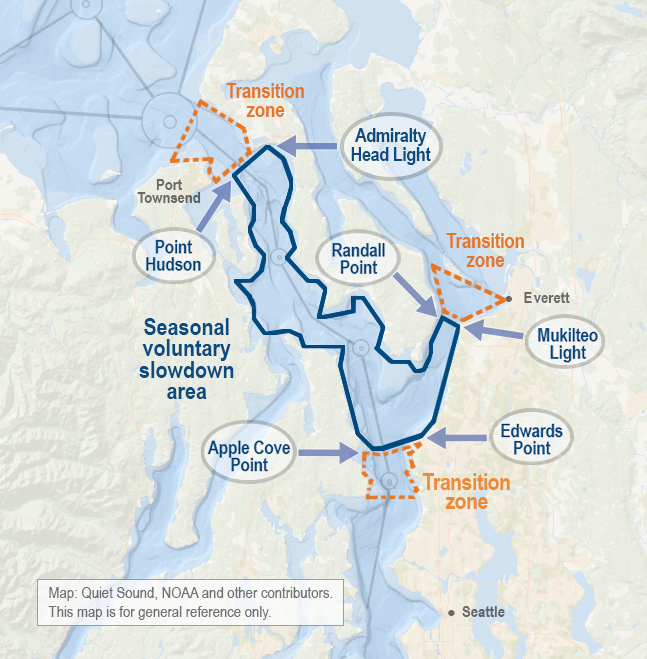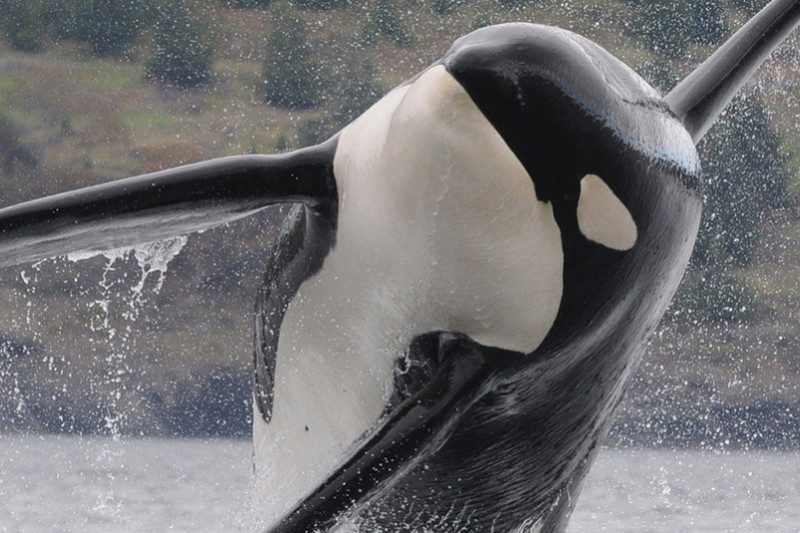A broad cooperative effort by Washington State maritime businesses, environmental groups, tribes and shipping operators is testing out how slowing ship traffic in Puget Sound might give endangered killer whales a survival edge.
With just 73 orcas left, the southern resident killer whale population of Puget Sound is one of the most precarious marine mammal species in U.S. waters. The Quiet Sound project is running the voluntary slowdown trial from Oct. 24 until Dec. 22.
It’s a season in the Admiralty Inlet and Puget Sound when the southern resident whales return from the Pacific to swim, rest and hunt salmon. The orcas’ success, or lack of it, will directly affect West Coast fishermen’s ability to catch king salmon, if regulators assess that more salmon must be set aside for the whales to eat.
Biologists know underwater noise interferes with the whales’ acoustic senses and their ability to hunt, navigate, and communicate. In late October, monitoring counted 25 killer whales in the slowed, quieter area.
“If it’s J Pod, that’s about right,” said Rachel Aronson, executive director of Quiet Sound, referring to whale researchers’ name for the orca group. “So we’re very glad the whales are here. That’s very motivating for the pilots and professional mariners who are at the helm.”
Quiet Sound’s origins go back to the Southern Resident Orca Task Force, formed in 2018 by Washington Gov. Jay Inslee. In 2019 the task force released recommendations for reversing the whales’ decline, including reducing vessel noise.
Orcas use sound to navigate, communicate and find food – their preferred chinook salmon – when they move into Puget Sound in summer and fall. Noise from shipping interferes with the whales’ sensory abilities.
“Even the mere presence of vessels within 400 yards can disrupt the southern residents, especially females, as they hunt for scarce fish, research led by the National Oceanic and Atmospheric Administration shows,” according to Quiet Sound.
“Like an underwater sprinter, adult orcas burn a lot of energy chasing chinook salmon, one fish at a time, and with less food to go around, adults struggle to catch enough to feed themselves, much less find the energy to reproduce and feed their hungry calves. A noisier ocean makes all of this more challenging.”
Quiet Sound organized key partners including federal and state government agencies, tribes, the maritime industry, and nonprofits, and obtained more than $800,000 in funding. Shippers including Maersk and car carriers Nissan and MOL joined.
“We’ve got the Puget Sound Pilots on board,” with their deep knowledge of navigating the region’s passages and ports, said Aronson.

The slowdown trial aims for limiting speeds to 11.5 knots for bulk carriers and tankers, and 14.5 knots for container and cruise ships (the cruise ship season in Seattle typically ends around Oct. 23).
Organizers calculate the reduction is yielding a 30 percent to 50 percent speed reduction over a reach of 80 nautical miles – and in most cases, won’t cost shipping companies and local mariners much more time.
Transits in the sound average about a dozen large vessels in and out every day, Aronson said.
“One of the reasons we picked the slowdown zones that we did is because there are no major ports,” said Aronson. “They just steam on through.” Recreational boating traffic is concentrated closer to urban areas and less of an issue for marine mammals, she said.
Washington State Ferries have their own safety protocol. “When a whale is sighted they slow within half a nautical mile,” and stop at a quarter mile distance, said Aronson. “But they’re not able to slow down for a whole two months.”
Quiet Sound is developing other projects, such as improving the regional Whale Report Alert System that provides commercial mariners with real-time alerts on whale sightings in Washington and Canadian waters, with funding from NOAA and the National Fish and Wildlife Foundation.
The Port of Seattle is funding a study of existing hydrophones – underwater microphones that record sound in the marine environment – to identify gaps in the Washington network now operated by various groups and agencies. “A complete and connected hydrophone network will help Quiet Sound monitor and analyze ship noise throughout critical orca habitats,” according to Quiet Sound.
The research organization Oceans Initiative has started a project to analyze existing sound levels in Washington waters and report on how these relate to known thresholds of noise levels likely to disturb fish and marine mammals. “The Puget Sound Partnership is the majority funder of this project. Quiet Sound supports this work through funding from Alaska Airlines via the Bonneville Environmental Foundation’s Promise the Pod Initiative. This research will aid Quiet Sound in understanding the baseline soundscape of Washington waters,” states Quiet Sound.
A longer-term ambition of the Quiet Sound program is “to support a market for new developments in vessel quieting and whale sensing technologies.” The group is collaborating with the U.S. Navy’s Northwest Tech Bridge on a technological challenge for developing a whale sensing system for vessels underway, with funding from the National Security Innovation Network.





